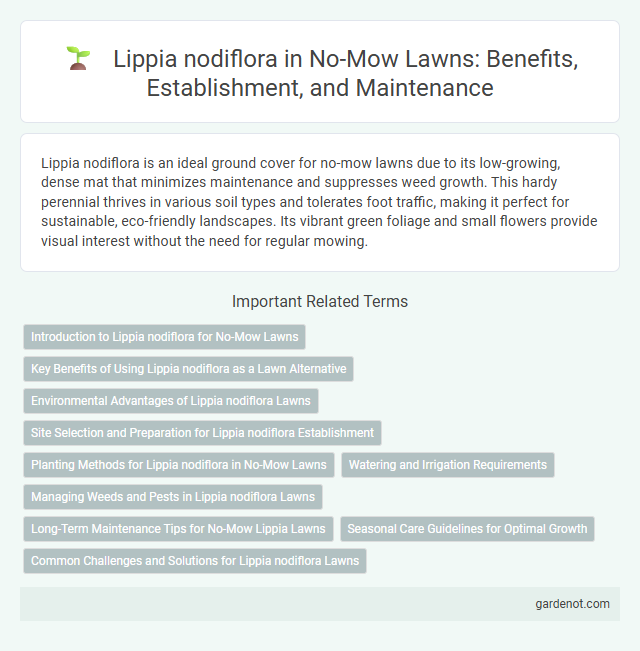Lippia nodiflora is an ideal ground cover for no-mow lawns due to its low-growing, dense mat that minimizes maintenance and suppresses weed growth. This hardy perennial thrives in various soil types and tolerates foot traffic, making it perfect for sustainable, eco-friendly landscapes. Its vibrant green foliage and small flowers provide visual interest without the need for regular mowing.
Introduction to Lippia nodiflora for No-Mow Lawns
Lippia nodiflora is a low-growing, hardy groundcover ideal for no-mow lawns due to its dense mat-forming habit and tolerance to foot traffic. This drought-resistant plant thrives in full sun to partial shade, requiring minimal maintenance and reducing water consumption compared to traditional grass. Its ability to suppress weeds and maintain a green, lush appearance year-round makes it a sustainable alternative for eco-friendly landscaping.
Key Benefits of Using Lippia nodiflora as a Lawn Alternative
Lippia nodiflora offers a low-maintenance, drought-tolerant alternative to traditional lawns, requiring minimal mowing and irrigation. This fast-spreading ground cover provides excellent weed suppression and enhances soil erosion control, making it ideal for sustainable landscaping. Its ability to thrive in various soil types and climates supports biodiversity while reducing lawn care costs and environmental impact.
Environmental Advantages of Lippia nodiflora Lawns
Lippia nodiflora lawns significantly reduce water consumption due to their drought-tolerant nature, making them ideal for sustainable landscaping in arid regions. Their dense, mat-forming growth suppresses weed invasion, reducing the need for chemical herbicides and thus minimizing environmental pollution. This low-maintenance ground cover enhances soil stability, preventing erosion and promoting healthier ecosystems.
Site Selection and Preparation for Lippia nodiflora Establishment
Lippia nodiflora thrives in well-drained soils with full sun to partial shade, making site selection crucial for optimal growth in no-mow lawns. Soil preparation should involve removing existing vegetation and lightly tilling the area to enhance root penetration and water infiltration. Incorporating organic matter improves soil fertility and moisture retention, facilitating successful establishment of Lippia nodiflora ground cover.
Planting Methods for Lippia nodiflora in No-Mow Lawns
Lippia nodiflora thrives best when planted using stolon cuttings or plugs, ensuring rapid ground coverage ideal for no-mow lawns. Preferring well-drained soil and full to partial sunlight, it establishes quickly, reducing maintenance and water needs. Proper spacing of 6 to 12 inches between plants encourages dense growth, effectively suppressing weeds and creating a durable, low-maintenance turf alternative.
Watering and Irrigation Requirements
Lippia nodiflora thrives with moderate watering, requiring consistent moisture to establish deep root systems, especially during the initial growth phase. Irrigation should be adjusted to maintain slightly moist soil without waterlogging, promoting drought tolerance once established. Efficient water management supports its resilience as a low-maintenance, no-mow lawn alternative in various climates.
Managing Weeds and Pests in Lippia nodiflora Lawns
Lippia nodiflora lawns exhibit strong natural weed suppression due to their dense, fast-spreading mat that effectively shades out invasive species, reducing the need for chemical herbicides. Its resilience against common pests minimizes damage, supported by its ability to thrive in diverse conditions, which limits pest habitat. Management practices include regular mowing to maintain turf density and occasional spot treatments to control stubborn weeds or pest populations without disrupting the lawn's ecological balance.
Long-Term Maintenance Tips for No-Mow Lippia Lawns
Lippia nodiflora thrives with minimal mowing, making it ideal for no-mow lawns, but long-term maintenance requires periodic trimming to prevent overgrowth and encourage dense coverage. Regular irrigation during dry spells helps maintain its vibrant green color, while occasional fertilization with balanced, slow-release fertilizers supports healthy root development. Controlling weeds through manual removal or targeted herbicides ensures Lippia nodiflora remains thick and weed-free without disturbing its natural low-maintenance appeal.
Seasonal Care Guidelines for Optimal Growth
Lippia nodiflora thrives with minimal mowing, ideally maintained at a height of 1 to 2 inches to promote dense, healthy growth. Seasonal care involves ensuring consistent moisture during spring and summer while reducing watering in winter to prevent root rot. Applying a balanced fertilizer in early spring supports vigorous growth and recovery after dormancy.
Common Challenges and Solutions for Lippia nodiflora Lawns
Lippia nodiflora lawns often face challenges such as weed invasion and uneven growth due to variable sunlight exposure. Managing soil pH between 6.0 and 7.5 and applying balanced fertilizers rich in nitrogen can promote uniform coverage and vigor. Regular trimming to a height of 1 to 2 inches helps control thatch buildup and maintains dense turf, reducing weed establishment.
Lippia nodiflora Infographic

 gardenot.com
gardenot.com